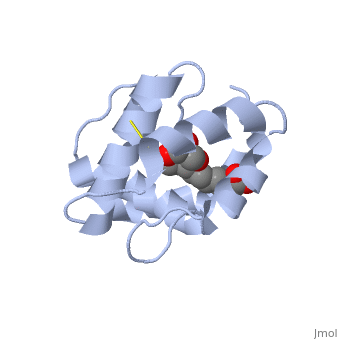Pheromone binding protein
IntroductionIntroduction
As the most ancient sense in nature, chemical communication plays a major role in successful mating, host and selection and other essential behaviors. This becomes crucial in social insects, where a complicated and delicate system of signals must be maintained in order to preserve the fragile equilibrium between the queen and the workers. Pheromone binding proteins are soluble proteins invovled in the early stages of pheromone detection. As a model protein of this family we will further describe the well investigated Pheromone binding protein of the honey bee.
Pheromone-binding protein ASP of the honeybee Apis mellifera L. (Hymenoptera: Apidea) was first isolated and characterized by Danty et al. (1998)[1] from the bee antennae. or to the article describing Jmol [2] to the rescue. StructureThe protein has a . Full crystallographic information is available from OCA. FunctionStructural highlightsThis is a sample scene created with SAT to by Group, and another to make of the protein. You can make your own scenes on SAT starting from scratch or loading and editing one of these sample scenes.
|
| ||||||||||
ReferencesReferences
- ↑ Pesenti ME, Spinelli S, Bezirard V, Briand L, Pernollet JC, Tegoni M, Cambillau C. Structural basis of the honey bee PBP pheromone and pH-induced conformational change. J Mol Biol. 2008 Jun 27;380(1):158-69. Epub 2008 Apr 27. PMID:18508083 doi:10.1016/j.jmb.2008.04.048
- ↑ Herraez A. Biomolecules in the computer: Jmol to the rescue. Biochem Mol Biol Educ. 2006 Jul;34(4):255-61. doi: 10.1002/bmb.2006.494034042644. PMID:21638687 doi:10.1002/bmb.2006.494034042644
